 Email: support@vespaagogo.com
Email: support@vespaagogo.comSaigon Travel
- Home
- Travel Tips
District 4 Saigon: A Local’s 2025 Guide to Food, Alleys, and Its Notorious-but-Lovable Past
2025-11-25
District 4 Saigon is one of those places where the city reveals its real personality. It’s small—just under 4 km²—but dense with life. The moment you cross any of the bridges from District 1, District 7, or Thu Duc City, the rhythm changes instantly. The streets tighten, the alleys multiply, the food smells thicken, and everyday life spills onto the sidewalks. Everything feels closer, louder, and warmer.
For many travelers, District 4 becomes the moment Ho Chi Minh “clicks.” It’s not curated or polished - it’s lived in. It’s where food carts roll into the alleys every afternoon, where tiny cafes hide under balconies, and where neighbors talk across doorways like an extended family. And although its past gave it a reputation as Saigon’s “mafia town,” today the district is buzzing, welcoming, and filled with some of the best local experiences in the city.
This guide takes you through the geography, the transformation, the truth behind the old reputation, and - most importantly - what to do in District 4 and what to eat in District 4 in 2025.
1. District 4 Saigon: Small District, Big Identity
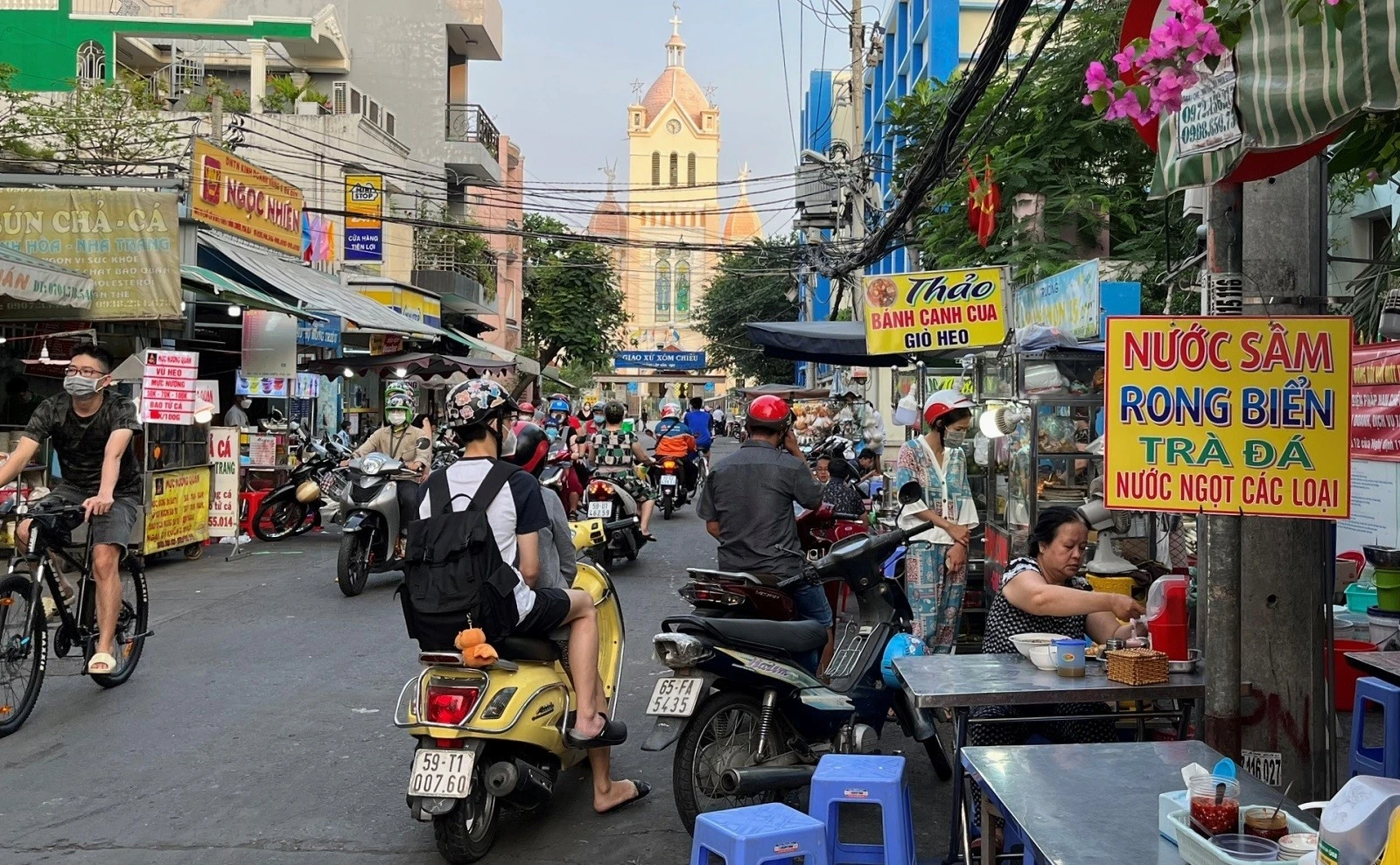
District 4 covers less than four square kilometers, but it packs more human energy per meter than almost anywhere else in Ho Chi Minh City. It’s framed on three sides by the Bến Nghé Canal, the Tẻ Canal, and the Saigon River. District 4 isn’t an island, but the waterways around it create a natural border that gives the district its own contained, self-sufficient world.
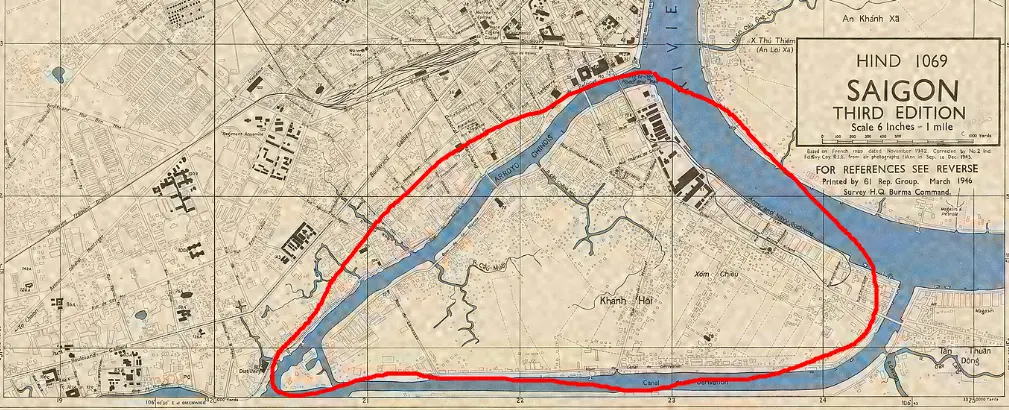 Old underdeveloped District 4 during the French time (1942)
Old underdeveloped District 4 during the French time (1942)
Step inside, and the geography becomes obvious. Major roads - Nguyễn Tất Thành, Hoàng Diệu, Vĩnh Khánh, Tôn Đản - break quickly into a network of narrow alleys, some just wide enough for a single motorbike. These hẻms aren’t shortcuts; they’re living communities. A single turn might reveal a tiny café with five plastic stools, a family setting up a dinner table outside their front door, a cart selling bánh tráng trộn, or a group of kids playing badminton in the only open space they can find.
Despite the density, the district doesn’t feel overwhelming. It feels close and familiar, even to newcomers. And because of its position—you’re minutes from District 1’s nightlife, District 7’s residential areas, and Thu Duc City’s creative hubs—District 4 has become a perfect blend of local character and city-center convenience.
It’s this mix of vibrancy, intimacy, and accessibility that makes District 4 one of the most fascinating places to explore in Ho Chi Minh City.
2. The District With a Reputation: What Locals Remember, What Visitors See Today
Long before District 4 became the unofficial seafood capital of Saigon, it carried an aura that older locals still talk about today. Ask anyone who grew up in the city, and they’ll lower their voice a little before saying:
“Quận 4 hồi xưa dữ lắm.”
(“District 4 used to be intense.”)

Back then, life here was cramped and chaotic. Canal-side slums packed families into tiny makeshift homes perched over muddy water, and the district’s dense maze of unnamed alleys made it easy for people - and trouble - to disappear quickly. In those days, District 4 wasn’t just a working-class neighborhood; it was the backdrop for some of Saigon’s most notorious characters. Pickpocket crews, street hustlers, and several infamous gang figures had roots here, and certain alleys became known citywide as places you didn’t enter without a reason. That’s how the nickname “mafia town” stuck—not because everyone was dangerous, but because the loudest stories came from this very district.
This reputation lingered well into the 90s and early 2000s. Not because of dramatic movie-style crime, but because District 4 had the perfect ingredients for a tough environment: busy port traffic, tight living spaces, constant night activity, and a street economy that never really slept.
But the transformation over the last two decades has been massive.

Bridges expanded. Roads widened. Street lighting improved. Riverside parks were developed. Families renovated old houses. New apartment blocks rose along the canal. The entire atmosphere softened without losing its character.
Today, District 4 still has an attitude—but it's approachable, warm, and often surprisingly charming. When you walk into the alleys now, you’re far more likely to encounter kids playing badminton, aunties selling evening snacks, and neighbors chatting across balconies than anything remotely dangerous.
And here’s the best part:
Because the district still carries the shadow of its old reputation, its alleys remain rich with unfiltered stories—many of which locals don’t share publicly online.
If you want to feel a touch of old District 4’s atmosphere, head to Alley 148 Tôn Đản — the place where the legendary mobster Năm Cam once lived, and one of the spots most closely tied to the district’s old “mafia town” reputation.
3. Is District 4 Ho Chi Minh City Safe in 2025?
Short answer: Yes.
District 4 today is one of Ho Chi Minh City’s most commonly explored local neighborhoods. In the evenings, families stroll along Bến Vân Đồn, young people gather in casual street cafés, tourists dine comfortably on Vĩnh Khánh Street, and foot traffic moves smoothly through the alleys from day to night. The atmosphere feels open, active, and friendly.
Of course, it’s still a dense urban district, so the usual Saigon awareness applies—keep your phone secure near traffic, avoid wandering into unfamiliar alleys very late at night, and stay aware in busy areas. These are general city habits, not District 4-specific warnings.
As a whole, the district is far safer than the reputation it carried decades ago. For both first-time visitors and returning travelers, District 4 is perfectly fine to explore and offers one of the most authentic slices of Saigon life.
4. What to Do in District 4 Saigon
District 4 is not a district of monuments or big museums—it’s a district of experiences. If you want to understand how Saigon lives, eats, and breathes, this is where you go.
4.1. Wander Vĩnh Khánh Street at Night
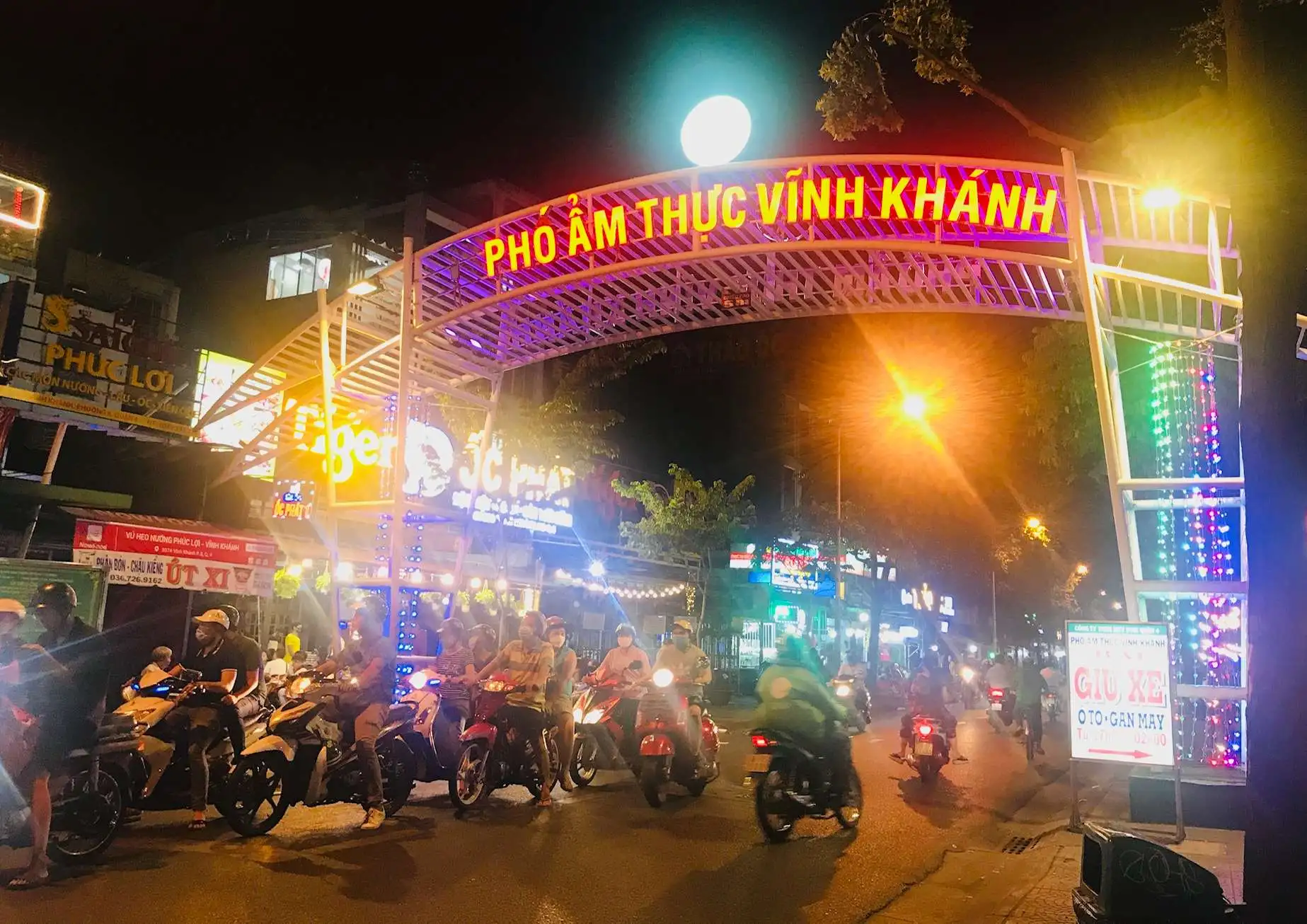
Vĩnh Khánh is the heartbeat of District 4’s nightlife. As the sun sets, the street erupts with movement: seafood grills firing up, smoke rising from charcoal, singers performing outside restaurants, and crowds flowing from stall to stall. It’s loud in the best way possible.
Dine on grilled scallops, snails in coconut milk, BBQ oysters, and clams with lemongrass. Sit on plastic stools, grab a cold drink, and take in the energy. This street alone answers half the question of what to do in District 4.
4.2. Explore Xóm Chiếu Market and Hẻm 200
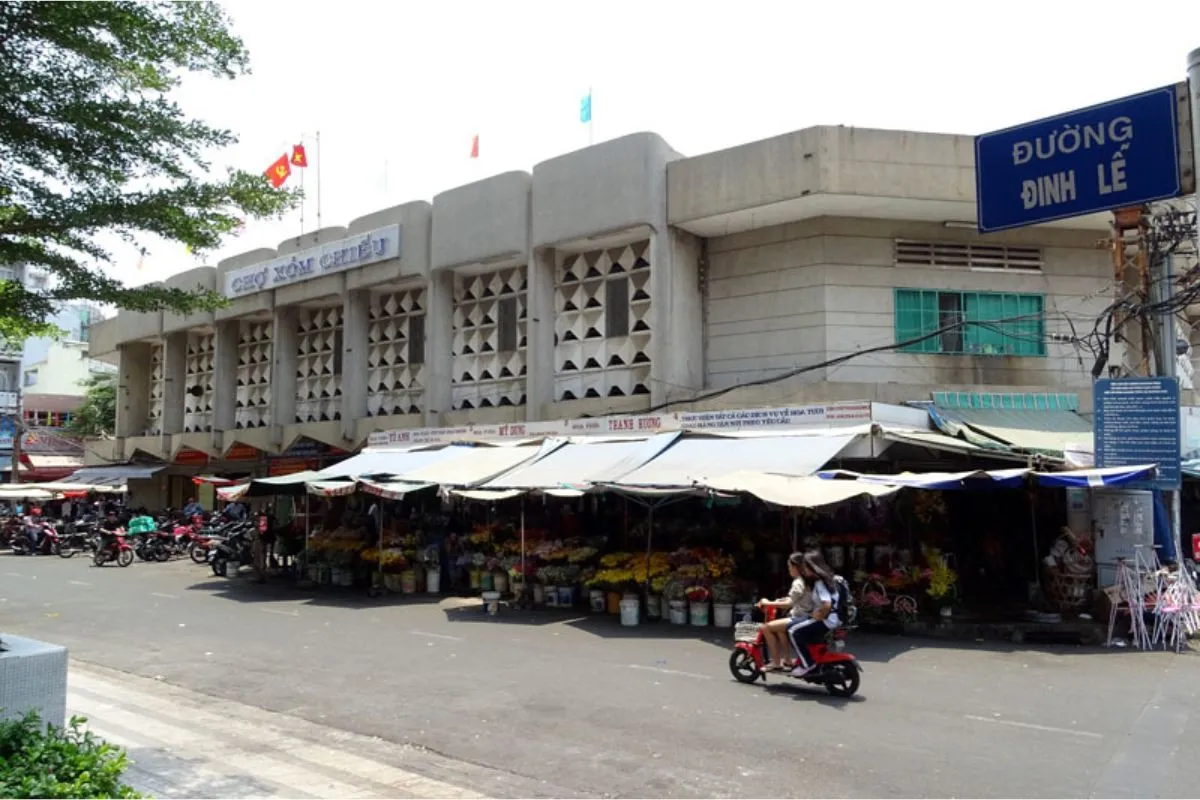
Xóm Chiếu in the morning is pure local life: vendors shouting prices, fresh seafood on display, produce everywhere, and families doing their daily shopping. But by late afternoon, the nearby alleys - especially 200 Market (alley 200 Xóm Chiếu street) - transform into a little snack universe. Bánh tráng trộn - grilled rice paper, noodles, miscellaneous fries, fresh fruit, and iced drinks appear like clockwork.
If you want to understand the district’s everyday rhythm, this area does it beautifully.
4.3. Take an Evening Walk on Bến Vân Đồn

Once a humble canal path, Bến Vân Đồn is now a relaxed evening spot popular with locals. From here, you get breezes off the water, a long open walkway, and a clear view of District 1’s skyline lighting up across the canal.
It’s the perfect cooldown after dinner.
4.4. Dive Into the Alleys (The Heart of District 4)
If you want to see Saigon at its most human, explore the alleys branching off streets like Hoàng Diệu, Vĩnh Hội, and Tôn Đản. You’ll find evening snack carts, coffee stalls, kids playing, and the soft hum of neighborhood life happening all at once.
4.5. Use District 4 as a Base to Explore Other Districts
Because it borders so many key areas, District 4 is one of the most strategic places to stay in Ho Chi Minh City. And if you want to understand how each district fits into the city’s larger picture, this guide pairs perfectly with your deeper overview on exploring the districts of Ho Chi Minh City.
5. What to Eat in District 4 Saigon
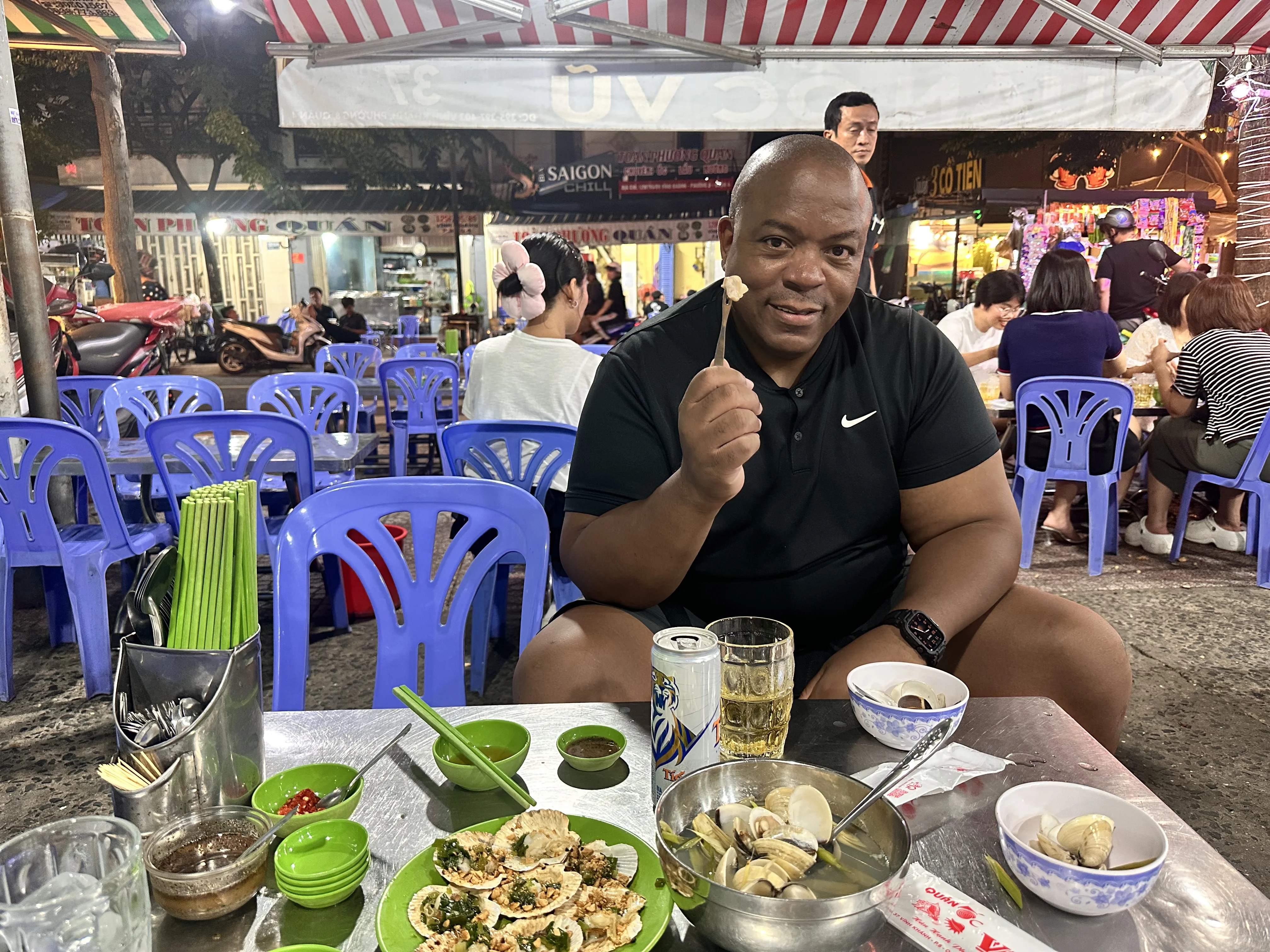
District 4 is famous for three things: seafood, street snacks, and authentic local meals. Here’s what you shouldn’t miss.
5.1. Seafood on Vĩnh Khánh
Grilled scallops, snails in different sauces, clams, razor shells, and oysters—this street is a seafood showcase. Prices are affordable, portions are generous, and the quality is consistent across most shops.
5.2. Bánh Tráng Trộn in 200 Market
As I said earlier, 200 Market in Alley 200 Tôn Đản is where the real authentic Vietnamese lies. For starters, find Rice Paper grilling directly on coal. This is where local students and workers grab an afternoon snack. Fresh rice paper, quail eggs, dried beef, chili oil, and herbs mixed on the spot are simple, addictive, and authentically Saigon.
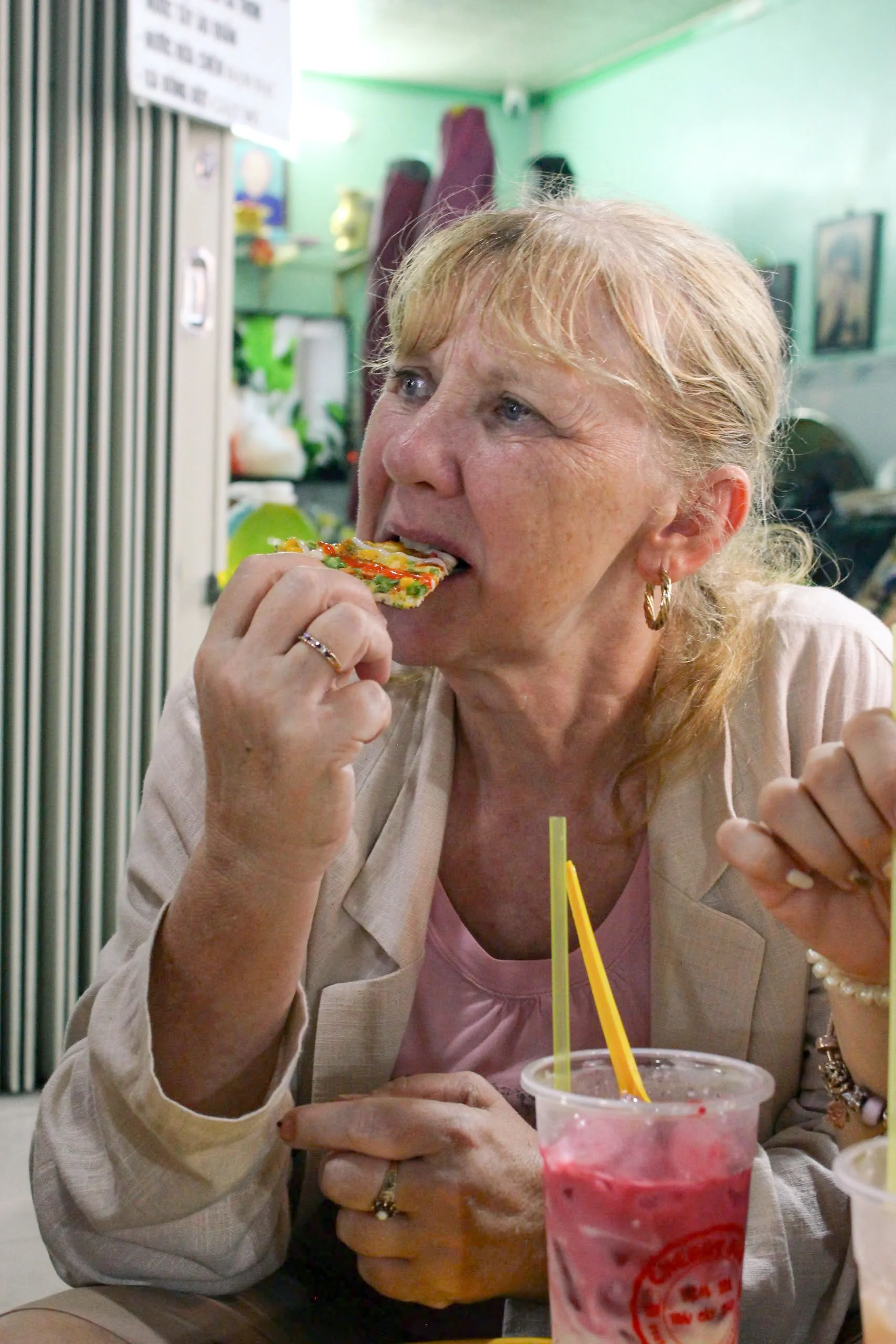
5.3. Morning Bún Riêu in the Alleys
District 4 has some of the coziest bún riêu spots hidden inside its hẻms. Expect rich broth, tomato sweetness, tofu, crab paste, and a very local atmosphere (and price).
Top spot: Bún riêu giò chả Thu Nga - Google Maps - Q32 Nguyễn Hữu Hào
However, you can find Bún Riêu in any local are in District 4 (you should a pro by now), so if it gets too crowded, just get in another spot.
5.4. Cơm tấm Hồng Calmette
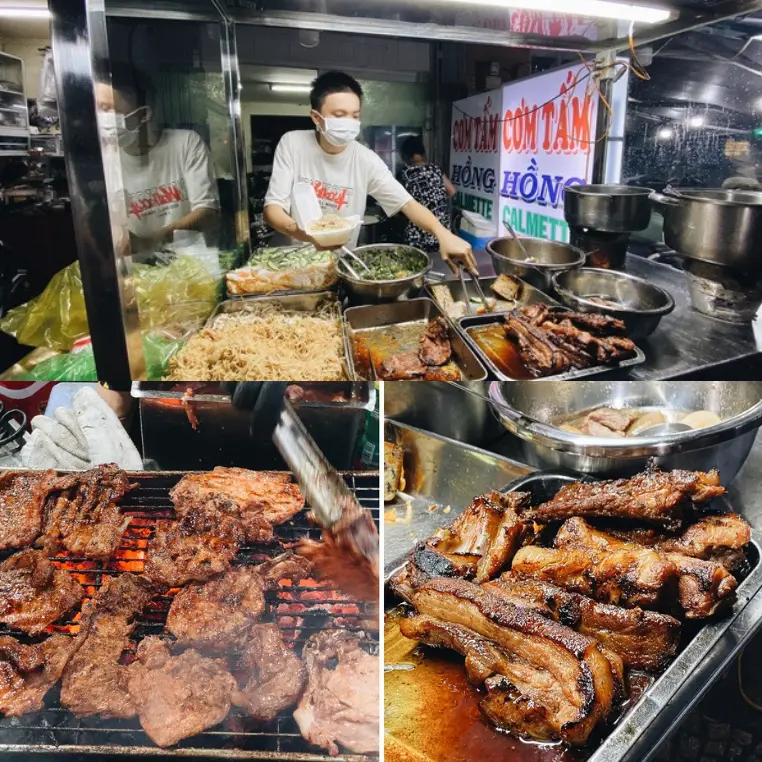
This long road heading toward the port is famous for broken rice stalls. Pork chop, shredded pork skin, fried egg—comfort food at its best.
Quán Cơm Tấm Hồng Calmette - Google Maps - 134 Hoàng Diệu
5.5. Mobile Dessert Carts at Night
Look for flan, chè, and grilled bananas as you wander through evening alleys. Most vendors rotate locations, but you’ll find plenty around Hoàng Diệu and Vĩnh Hội after 6 PM.
My personal hack: sit at this smoothie place right on the sidewalk Nước ép sinh tố - Đăng Mập - Google Maps. While you enjoy your favorite smoothie with real locals, snack and dessert vendors will surround you. It’s my favorite spot to sit down and order a bunch of different snacks passed by.
6. The Classic District 4 Route (Easy, Safe, Well-Rounded)
Perfect for first-time visitors who want a clean overview.
➤ Stop 1 — Calmette Bridge Viewpoint
Start your walk with a view over the canal and skyline. Great photo opportunity. Under the bridge is the famous Cơm Tấm Hồng (broken rice) I mention earlier.
➤ Stop 2 — Xóm Chiếu Market
Walking straight down a few hundred meters is Xóm Chiếu Market. A bustling scene of daily life: vendors, fresh produce, and the classic organized chaos of Saigon markets.
On the opposite of the place is Ốc Nho, which has been around for who knows how long, where you can enjoy their signature Snail Fondue dish (order “ốc né”) and enjoy the authentic market vibes.
➤ Stop 3 — 20 thước street

Just a minute walk away from Com Tam Hong Calmette is the 20 Thuoc street
A friendly, easy-to-navigate alley ideal for understanding local culture: neighborhood chatter, evening food carts, coffee stalls, laundry and small shops. Here, they serve the best flan and jello in town (you won’t miss it, 20 thước is covered with those desserts).
It’s a gentle introduction to the famous District 4 alley experience.
➤ Stop 4 — Dinner on Vĩnh Khánh Street
Seafood, people, music, and endless energy. A must-stop.
Pick your favorite restaurant, either BBQ or Seafood, you’ll have a great time. Personal recommendation:
- Chilli Lẩu Nướng Quán - Google Maps - 232 Vĩnh Khánh - BBQ and hotpot
- For Seafood: Any restaurant you vibe with, they’re all the same.
Better to spend time here around 7pm onwards. The street will be as loud and chaotic as you might like, there’s even street performances right on your shoulder.
➤ Stop 5 — Bến Vân Đồn Riverside Walk
End the evening with a slow walk or coffee by the canal.
7. The Adventurous Alley Route (For Travelers Who Want the “Real” Local Texture)

This route is about immersion, not sightseeing. You’ll see Ho Chi Minh City in its purest daily form.
➤ Stop A — Deep alleys off Hoàng Diệu Street, Tôn Đản street
Families cooking outdoors, kids playing, tiny food carts, micro-cafés.
➤ Stop B — Old-Ports near Tôn Thất Thuyết
A few minutes away, Tôn Thất Thuyết carries a completely different energy. This street feels completely different to the district’s old port roots — older homes, long-time residents, small mom-and-pop shops, and a quieter, more grounded atmosphere. If you want a glimpse of what District 4 felt like decades ago, this is the place.
(you might even stumble on hidden street food gems, but get some probiotics beforehand, as it can be overwhelmed for your stomach)
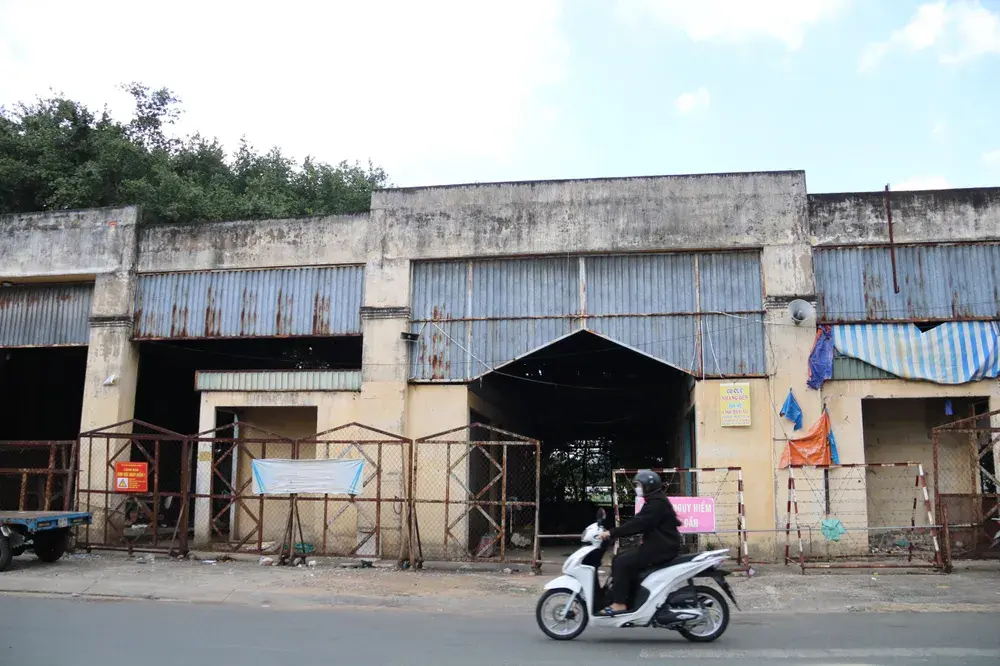
➤ Stop C — More exotic foods in 200 Market
Flan, chè, and banana desserts appear in the early evening along various inner streets. Follow your senses.
But this is the adventurous route, so be ready for some bold bites (which the locals actually love):
- Quán Phá Lấu Bò Cô Thảo - Google Maps - 243/29G Tôn Đản street - Stew cow organs in fragrant coconut broth (my personal favorite).
- Bún riêu giò chả Thu Nga - Google Maps - Q32 Nguyễn Hữu Hào - A variety of rice noodle soup with broth and toppings made from crab (the ENTIRE crab)
- Bánh tráng chả mực Vũ - Google Maps - 203 Tôn Thất Thuyết - Squid paste wrapped in rice paper and got deep fried. You love seafood? This is the crunchy special for you.
- Babylon snail with salted egg sauce - order “ốc hương trứng muối” at any restaurant in Vĩnh Khánh. You’ll be surprised how good snail can taste (trust me, I have these every Sunday).
➤ Stop D — Sit at an alley café
Order iced tea and Vietnamese coffee (cà phê sữa đá, that’s what you should say).
Take a rest at any small coffee cart you may find in the alleys.
Quick tips: Plastic stools and tables (either red or blue) are signs of those real local coffee.
Sit back and feel the flow of local life around you.
Conclusion
District 4 Saigon is one of the most rewarding districts to explore if you want to experience the city the way locals live it. Its transformation from a tough port neighborhood to a vibrant, close-knit community gives it a personality few other districts can match. Add the legendary food, the intimate alley scenes, and the canal views, and you have a district that stays with you long after you leave.
If navigating all this sounds overwhelming—or if you want to explore District 4 with a local expert who knows the stories behind every alley—our team at Vespa A Go Go is here for you. On our Dining Delights tour, we eat right in the heart of District 4’s food scene. And on our See Saigon tour, we take you through both District 4 and District 1, showing you how the city connects, breathes, and comes alive.
If you want the real Saigon, let us take you.
Duy Le - Marketing Manager
I’m Duy Le, the Marketing Manager at Vespa A Go Go, with three years of experience in marketing and storytelling. My passion lies in helping both travelers and Vietnamese people discover the authentic value of our country’s history and culture. I believe Vietnam travel should be more than just sightseeing — it’s a way to truly connect with Vietnam’s heart and spirit. Through my work, I aim to inspire curiosity, respect, and appreciation for the stories that make Vietnam unique. When I’m not crafting campaigns, I love exploring Saigon’s hidden corners on my Vespa, always in search of the next story worth sharing.
Other tips
- Binh Thanh District: Saigon’s Most Underrated Street Food Area on Ancient Ground
- Is Traffic Bad on Christmas Eve? The Truth About Traffic Christmas Eve Vietnam
- The Ultimate Guide: 16+ Best Shops for Souvenirs from Ho Chi Minh (2025 Edition)
- District 4 Saigon: A Local’s 2025 Guide to Food, Alleys, and Its Notorious-but-Lovable Past
- Finding a Coffee Shop in District 2: 20 Hidden Gems in Thao Dien
- Discovering District 1 in Saigon: The Heartbeat of Ho Chi Minh City
- Discover the Modern Oasis of Saigon: A Local’s Guide to District 7
- Discover the Charm of Saigon's East Side: A Local’s Guide to District 2
- Discover the Heart of Saigon: A Local’s Guide to District 3
- The Soul of Saigon: Life on a Motorbike
- Exploring the Districts of Ho Chi Minh City: A Tapestry of History, Culture, and Daily Life



